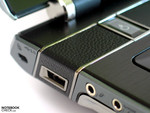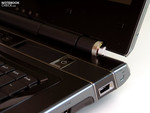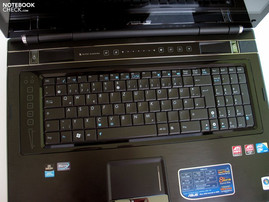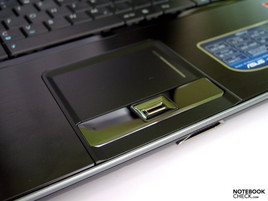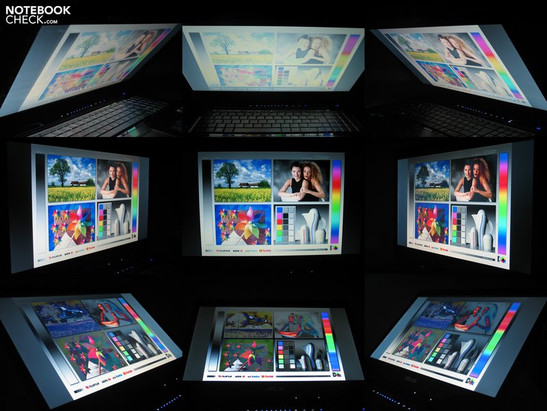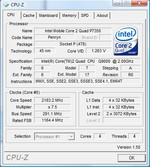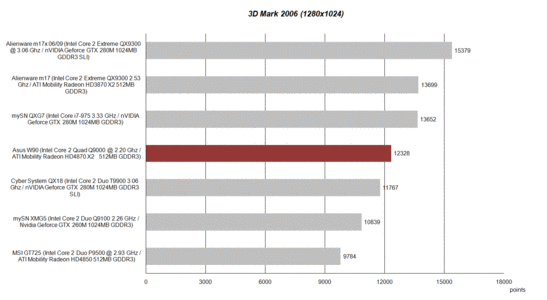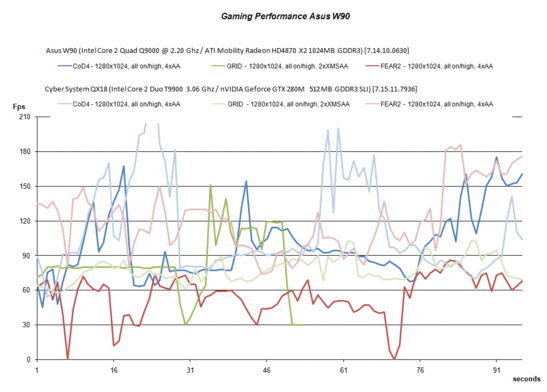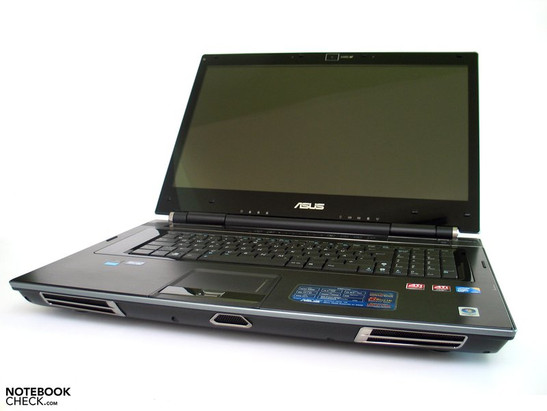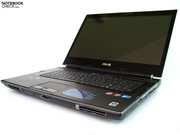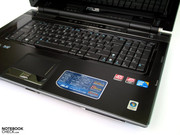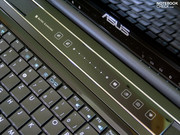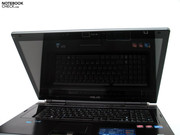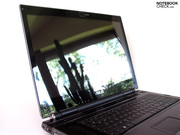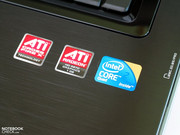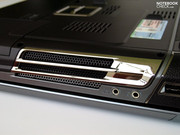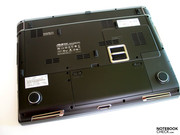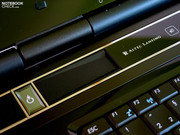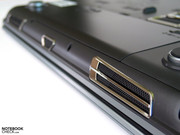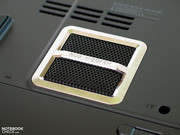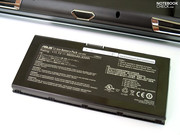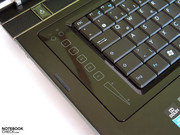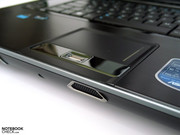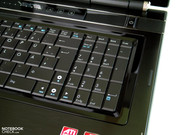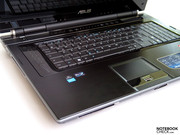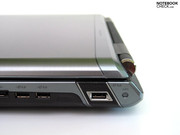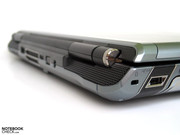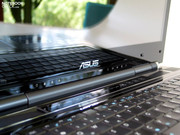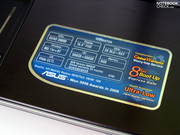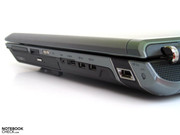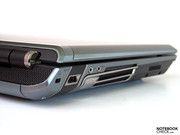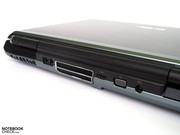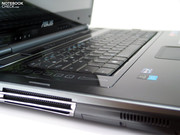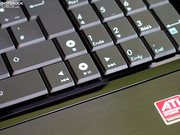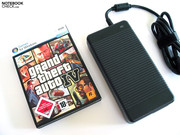Review Asus W90VP Gaming Notebook
Heroes die young.
At Cebit this year the W90 from Asus was still the big eye-catcher, where it promised gaming performance, which you would otherwise more likely find from the Alienware camp. Although Asus rightly worked flat out on the design of the case, the deployed hardware was first and foremost the reason for the overall interest in the notebook. Two Mobility Radeon HD4870 graphics cards connected via Crossfire should have put the fear of God into the competition. – yeah, should have…
A few weeks ago the fear was finally confirmed: the Asus W90 is history. The commercial potential is obviously smaller that you could have expected for a high-end gamer, which the W90 had been designed as. Well, you could have also thought of that about Asus beforehand, a lot of people will now think. Sure, the current economic trend must have also played an important role, and it inevitably came willy-nilly as a surprise in regard to the development period of the device.
The stock of each notebook shop around the world will still be sold, but there will be no more stock replenishment from Asus. Nevertheless we will still view the device in the framework of a comprehensive review, especially because of the exciting hardware.
Case
Alongside the fully high-gloss uniformity when it comes to consumer notebooks of the entry- and middle-class the design of the W90 is almost exciting. Similar to the Lamborghini range, diamond-shaped stylistic elements are taken up as a theme and this is quoted in numerous details. Above all the fan opening proved to be striking, as well as the loudspeaker opening on the front. Overall the chassis of the W90 seems thoroughly elegant despite its mightiness. Indeed this says a lot about the very competent work of the designer.
Subtly placed chrome elements and successful material alteration make for a well-balanced structure of the case, whereby it is to be positively noted that the notebook seems nevertheless in no way playful.
Since the Asus U1F, leather also belongs to the preferred materials of Asus. With that the entire wrist-rest area is covered with this precious material, so on the Asus W90 if anything the optical effect overweighs. Alongside the surface-effect plastic and metal surfaces, the selective leather applications in the area of the hinges are pleasing. Also the alteration of matte and glossy surfaces is successful, where on the whole a very harmonious and above all high-quality impression arises.
The quality of the workmanship of the Asus W90 can be considered consistently good. On closer inspection of the case indeed smaller weak points regarding the paintwork and clearing can be discovered, yet on the whole these remain negligible.
It's similar when it comes to the stability of the giant case. Here too, the case selectively and minimally gives way. As the chassis certainly doesn't allow any distortions and practically no cracking noises when handled, here we can also give a positive impression.
The display is in its dimensions rather reminiscent of a desktop TFT screen. It certainly features a comparable stability. The large and thoroughly robustly effective hinges can limit a see-sawing of the panel. Also you have to do without a locking shutter with the base unit on the display, which is indeed to be disregarded on a DTR laptop.
Connectivity
When it comes to connections the Asus M90 has a few to offer. On the left lateral edge you'll firstly begin with the opening for the fan in the middle to the rear area. Similarly you will find the connection jacks for headphones (S/PDIF) and a microphone as well as an USB port and the Kensington Lock in the rear corner area.
Also on the opposite side the ports are really thoughtfully placed. In the front area the Blu-Ray drive with an overlying ExpressCard slot as well as a card reader make for an interference-free operation alongside the notebook. In the rear half you'll still find Firewire, eSATA and 3x USB.
The front side exclusively belongs to the designers, who have placed three openings for the integrated speakers here. Only on the rear does it come back to the connection round-dance. Here the more permanent and above all often rather bulky plugs and cables have been reasonably positioned: LAN and modem, HDMI, VGA and the power supply.
With regard to communication the W90 makes for a comprehensive package with Gigabit Ethernet, WLAN from Atheros (AR928X) and integrated Bluetooth.
Input Devices
Amidst the massive case the offered keyboard seems rather compact. A somewhat clearer layout would have been nice in any case. The standard keypad shows no abnormalities regarding the placement of the keys, as all keys have a sufficient size. Furthermore you can profit from a separate number pad.
The typing feel is to be described as rather jerky and medium deep. In the area of the enter key the keyboard unit was also slightly bowed, which expressed itself in a springy feel when typing.
We couldn't make friends with the touch-sensitive control panel on the left alongside the keyboard, in particular with the volume adjustment positioned here. It requires some practise to bring the volume of the sound onto the desired level. The well-known combination of FN and an F-key would have also sufficed and would have probably even made it more precise to use.
It's a similar case for a control zone above the keyboard, which allows the adjustment of the brightness of the display. Well, apart from the fact that adjusting the brightness of the display is undertaken less often as for example the volume and so such a present button has no real justification, the touch-surface is all the same only laborious and more or less imprecise to operate.
The touchpad provides a basically good surface of adequate size. Also both keys are pleasant to use.
On the whole you must note that not only the keyboard but also the touchpad suffer from the height of the base unit, which reaches a proud 40 mm on the leading edge. This causes a hand posture that is often not ergonomical.
Display
Asus equips its "prestige gamer" with an 18.4-inch Full HD panel. With a resolution of 1920x1080 pixels you can therefore profit from the highest picture quality in 1080p Full HD, supported by the deployed Blu-Ray drive. The reflective display in edge-to-edge design is thereby practically a must-have.
Regarding brightness the built-in panel (CMO1804) provides a maximum value of 174.9 cd/m². Furthermore clear brightness wastage in the upper corner areas of up to 122.7 cd/m² is noticeable. For this reason the Asus W90 turns out to be only below average in terms of illumination with just 70%. It doesn't look any better when it comes to the maximum possible contrast, which due to a black value of 1.09 cd/m² reaches only 160:1. Likewise in the best of cases it's to be graded as average.
| |||||||||||||||||||||||||
Brightness Distribution: 70 %
Contrast: 160:1 (Black: 1.09 cd/m²)
The colour production leaves behind a good subjective impression. The produced image always seems strong and well-balanced. Also the image stability is horizontally good, whilst in the vertical field colour changes are swiftly seen. Unfortunately disturbing reflections are constantly present, even indoors with average surrounding brightness.
Performance
It should become a real gamer. As a partner for graphic solutions ATI is chosen and Intel accounts for the CPU. So far nothing out of the ordinary. With the Mobility Radeon HD4870 it should certainly be the strongest mobile graphics chip the AMD/ATI currently offers in the notebook range. No other device currently uses this hardware, which of course cranks up interest in the device once more. And now the absolute show-stopper: Asus even builds in two graphics cards of this kind, and indeed in Crossifre connection, similar to the SLI system from the competition, Nvidia.
Now onto the CPU. A Q9000 chip from Intel comes into play, so four cores in Penryn architecture (45 Nanometer), 1066 MHz FSB, 6MB L2 cache and a TDP of 45W. The problem: the clock-speed. The four cores bring only 2.0 GHz. So what was possibly meant well, that is the W90 with a future-proof 4-core CPU, quickly emerges as a mistake, unfortunately. The multi-core support in games is as always very limited, even in the newest titles. Megahertz or better said Gigahertz as always brings home the bacon in the fight for additional frames in the benchmark tests. This was also the verdict in our special test of the Intel Quad-Core range.
Of course, in view of the future a Quad-Core is surely a good choice, but who wants to wait months or maybe years for 4-cores to meet their complete potential in games. Until then the deployed graphics solution will probably be overtaken, even if it currently counts as the best performing.
Regarding the extent that the device is future-proof, one thing is to be mentioned: driver support. As the following tests will show, the initial state of provided drivers on the device is aged and is not optimal on some games. Furthermore it poses the question of how the future support of a graphics solution on the part of ATI looks, which up until now has been built into exactly one model and which has already been taken out of production…
In the 3D-Mark 2006 standard test the first anticlimax already follows: 12.328 points are reached by the Asus W90 at our standard resolution of 1280x1024 pixels. For this we indeed already had to activate the "overclocking mode", which squeezes 2.2 GHz out of the Q9000 CPU. With the normally-clocked CPU it reached 11328. Here, other gamers reach more than 13000 points, where the Alienware M17x leads the list unchallenged with its currently unbeaten 15379 points. Indeed, all models use more powerful CPUs, as the Q9000 in the W90 is once more identified as a bottleneck. Detailed gaming tests follow in the next chapter.
What else does the W90 have to offer apart from CPU and GPU? Well, that would be the total of 6GB main memory indeed of the DDR2 type, divided up onto three 2GB modules. Also when it comes to memory you should find a total of one terrabyte of capacity, that's one thousand gigabytes, to suffice. Both of the discs from Seagate (ST9500325AS) spin at 5400 rpm and comprise 500GB. In the HDTune benchmark test data transfer rates of up to 78.7 MB/sec and an access time of 17.9 ms are specified. Both values are average.
| 3DMark 05 Standard | 14329 points | |
| 3DMark 06 Standard Score | 12328 points | |
| 3DMark Vantage P Result | 8396 points | |
Help | ||
| PCMark 05 Standard | 7229 points | |
| PCMark Vantage Result | 4409 points | |
Help | ||
Gaming performance
So what's the gaming performance of the Asus W90 like? As usual, numerous well-known games are put to use in the test.
CoD4
The classic shooter Call of Duty 4 is of course a must in the performance test. It shouldn't surprise that in a gaming monster the main focus is first and foremost on high graphics details.
No sooner said than done, we tested by means of a standardised play-through of a passage in the first single-player level as usual. We benchmarked the system with the settings at 1280x1024, all graphics options on or respectively on high as well as 4x antialiasing. As always the tool Fraps logged the results.
In the test the Asus W90 showed a consistently good performance in the test. The achieved frame rate practically constantly lay over 60 fps. On average the notebook reached 99.8 fps. Compared to this the Clevo M980NU with Nvidia Geforce GTX 280M SLI, indeed with a T9900 CPU with a stronger 3.06 GHz, only minimally exceeded these results, and respectively in sections recorded higher outliers upwards. For this reason this also exists on average with 119.3 fps.
Racedriver GRID
The driving-simulator GRID is a representative of a completely different genre. Also here demanding settings came into play (1280x1024, all options on or high, 2x XMSAA). It started with a good 45-60 fps. On the whole the performance remains approximately between 30 and 60 fps and for this reason in the always fluid region.
The Clevo M980NU remains somewhat steadier with a frame rate of 70-90 fps. On average the M980NU lies at 77 fps and comparatively the W90 at 52 Fps.
FEAR2
As a representative of the current shooter generation we also looked at FEAR2. At a resolution of 1280x1024 pixels, all graphics details on or high and activated 4x antialiasing the W90 provided frame rates of up to 60-70 fps yet it experienced short dips down to under 15 fps which become noticeable in short judders. This could possibly be down to a fault with the drivers. Here the Clevo with Nvidia GTX 280M SLI graphics turns out fundamentally better. Here the frame rates remain at an average of 123 fps.
GTA IV
The performance with the CPU hungry GTA IV also turned out rather sobering in the test. Even before the benchmark run-through it is certain that with a Q9000 CPU not a lot will be achieved. The integrated benchmark test swiftly confirms this fear. Barely 32.27 fps is provided by the notebook on average at the medium details level (1024x768 pixels, med. presets, 21/10/50/8). The M980ONU can record a good and playable 45 fps despite a dual-core CPU, indeed with a full 3.06 GHz.
Certainly GTA would thwart the graphics configuration of the W90 also at higher details. In order to choose a high texture quality, the game requires more than the offered 512MB GDDR3 video memory. Here too, two graphics cards don't help.
Verdict
In a nutshell we can only say one thing: shame.
It's a shame that Asus doesn't support the potential of the in-built graphic solution with an appropriate CPU, and furthermore it's a shame that ATI is a long time coming with regard to driver support for the deployed graphic solution. Apart from this, the HD4870 would have good preconditions for a price/performance lead.
According to various forum reports it should be possible to spruce up the Asus W90 with specially modded drivers. Also from an overclocked Q9000 up to 2.7 GHz or a swap to the fundamentally stronger QX9300 chip is partly the discourse. What does that bring? Well, posts of 17.000 points in 3D Mark 2006 and more speak for themselves. Even the current Alienware M17x with overclocked QX9300 CPU (3.06 GHz) and two Geforce GTX 280M only reached around 15.400 points with us. For this reason ATI would have made the grade. Would have, in order to stay in the subjunctive. What a shame.
Emissions
System Noise
The background noise proves to be thoroughly acceptable for a gaming machine. Without load in idle or office use the fan is indeed always in use, yet at 36.6 dB(A) it stays within passable limits. If you activate the overclocking function of the CPU, the system gets louder and reaches 38.5 dB(A).
With the overclocked CPU under constant load we could get a maximum of up to 47.6 dB(A) from the device. The graphics chip certainly remained comparatively cool for ATI standards with just over 80°C.
Noise level
| Idle |
| 33.6 / 33.6 / 38.5 dB(A) |
| HDD |
| 36.8 dB(A) |
| DVD |
| 38.5 / dB(A) |
| Load |
| 38.2 / 47.6 dB(A) |
 | ||
30 dB silent 40 dB(A) audible 50 dB(A) loud |
||
min: | ||
Temperature
Whilst the palm rests below the keyboard with just over 30°C remain comparatively cool, in the rear area of the upper side of the base unit it could clearly drastically heat up to 44.8 °C.
On the underside of the case the temperature characteristics turned out very similarly. A maximum heating up of 46.9 °C was recorded here.
(±) The maximum temperature on the upper side is 44.8 °C / 113 F, compared to the average of 40.4 °C / 105 F, ranging from 21.2 to 68.8 °C for the class Gaming.
(-) The bottom heats up to a maximum of 46.9 °C / 116 F, compared to the average of 43.3 °C / 110 F
(+) The palmrests and touchpad are reaching skin temperature as a maximum (34.8 °C / 94.6 F) and are therefore not hot.
(-) The average temperature of the palmrest area of similar devices was 28.8 °C / 83.8 F (-6 °C / -10.8 F).
Loudspeakers
The offered sound can be described on the whole as full and almost bass-heavy. In addition there are countless software-side settings possibilities in order for the 5.1 loudspeaker arrangement to fit to the individual preferences of the user. In shipped condition the central speaker on the leading edge was configured as rather too present for our taste.
The maximum volume of the sound system suffices for acceptable music playback. Also use in the gaming and video realm is thoroughly imaginable.
Battery Life
In a relevant well-performing desktop replacement, like for example the Asus W90, the integrated battery is as a rule a minor matter, and if anything serves as an emergency power source, should the mains briefly cut out.
Nevertheless with a battery pack with a capacity of 93 WH the Asus obviously tries in spite of this to inspire an idea of mobility in the W90. However it remains that the determined run times turn out to be less than promising.
The maximum battery life to be expected, determined by the BatteryEater Readers test (energy-saving profile, min. display brightness) amounted to 93 entire minutes. At just under 90 minutes, or around 1.5 hours the battery life ran in practical WLAN use, which is marginally under this mark.
Under load you shouldn't have too high hopes. The Asus W90 holds out for barely 49 minutes in the BatteryEater Classic test.
| Off / Standby | |
| Idle | |
| Load |
|
Key:
min: | |
Verdict
At risk of repeating ourselves again: shame. The Asus W90VP would have absolutely had the stuff for a successful gaming notebook. Care has not only been taken in making the case, but also when it comes to the design and the quality of the workmanship. The result is exhibited in any case - Asus W90VP is positioned far removed from the playfulness of so many colourfully flickering gaming notebooks.
The deployed display shows weaknesses. Here the probable cost pressure becomes noticeable, as the panel only features lukewarm brightness and cannot really convince when it comes to illumination and contrast.
The absolute essential for the W90 is performance - full stop. The in-built quad-core CPU seems promising at first look, yet one should have invested in a higher-clocked dual-core. Four cores are up until now still simply insufficiently supported.
Finally, also the deployed graphics solution suffers from this, which with two ATI Mobility Radeon HD4870 chips would have absolutely had the stuff to be a front-runner. Indeed ATI also has to put up with the accusation that such negligent driver support, even for the top graphics solution from AMD/ATI, does no good at all. For this reason there is also the question of the future of this graphics solution. The W90 was and is the only device which falls back on both of the 4870 chips. Well the production has also been discontinued, which won't really increase the incentive for ATI to bring out new drivers, on the contrary.
Because of the arising inconsistencies when it comes to CPU and drivers the W90VP is a tip for nerds and tuners who could conjure up a gaming machine from a 2300 Euro device, which could even make the current Alienware M17x range look old. Yeah…, could.
Many thanks to Notebook.de which kindly provided us with the test device. Here you can configure and buy the device.





